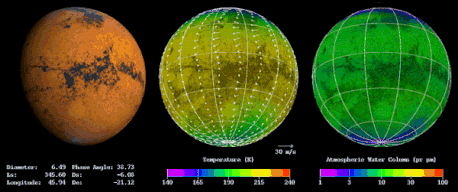화성 일반 순환 모형
Mars general circulation model이 기사에서는 관련 주제에 대해 고도로 전문화된 한 가지 측면만 설명합니다. 에 사항이될 수 . (2021년 8월) |
화성일반순환모델(MGCM)은 화성 대기의 일반순환 특성, 순환이 어떻게 추진되는지, 그리고 장기적으로 화성 기후에 어떤 영향을 미치는지 이해하기 위한 NASA의 연구 프로젝트의 결과물이다.
구조
화성 기후 시뮬레이션 모델은 바이킹의 화성 임무까지 거슬러 올라간다.대부분의 화성 기후 시뮬레이션 모델은 재사용되거나 공개되지 않은 개별 연구자들에 의해 작성되었습니다.1990년대에는 기후 모델링과 연구에 대한 인터넷의 일반적인 영향 때문에 통합 모델 코드베이스의 필요성이 대두되었다.현재의 화성 기후 시뮬레이션 모델은 인터넷 시대에 그 기원을 두고 있다.
이 화성 기후 모델은 가스에 의한 대기 가열 과정과 지상 공기의 열 전달 및 대규모 대기 [1]운동을 나타내는 복잡한 3차원(높이, 위도, 경도) 모델이다.
현재 모델은 BOINC와 같은 분산 컴퓨팅 시스템에서 사용하도록 수정되지 않았습니다.
화성의 메탄
화성 대기에는 10nmol/mol 메탄(CH)[2]이4 함유되어 있습니다.2014년, NASA는 큐리오시티 탐사선이 2013년 말과 2014년 초에 주변 대기에서 메탄이 10배 증가한 것을 감지했다고 보고했다.이 기간 동안 두 달 동안 네 번의 측정 결과는 평균 7.2ppb로, 화성이 알려지지 않은 [3]근원으로부터 메탄을 생성하거나 방출하고 있다는 것을 암시한다.그 전과 후의 판독치는 평균 그 [4][5][3]레벨의 10분의 1 정도였습니다.2018년 6월 7일, NASA는 대기 중 [6][7][8]메탄 배경 수준의 주기적인 계절 변동을 발표했다.
화성 메탄 발생의 주요 후보로는 물-바위 반응, 물의 방사 분해, 황철산염 생성과 같은 비생물학적 과정이 있으며, 이 모든 과정들은 CO 및 [9]CO와의2 피셔-트롭쉬 합성을 통해 메탄과 기타 탄화수소를 생성할 수 있는 H를 생산한다2.또한 메탄은 [10]물, 이산화탄소, 그리고 화성에서 흔한 것으로 알려진 미네랄 올리빈과 관련된 과정에 의해 생성될 수 있다는 것이 증명되었다.
메타노겐과 같은 살아있는 미생물이 또 다른 가능한 원천이지만,[11][12][13] 화성에서 그러한 유기체의 존재에 대한 증거는 발견되지 않았다.
다른 행성들
목성, 토성, 해왕성, [14]금성에 대한 지구 기후 시뮬레이션 모델이 있습니다.
「 」를 참조해 주세요.
레퍼런스
- ^ "Mars General Circulation Model – Research". NASA. Archived from the original on 2007-02-10. Retrieved 2007-02-25.
- ^ ESA Press release. "Mars Express confirms methane in the Martian atmosphere". ESA. Archived from the original on 24 February 2006. Retrieved March 17, 2006.
- ^ a b Webster, C. R.; Mahaffy, P. R.; Atreya, S. K.; Flesch, G. J.; Mischna, M. A.; Meslin, P.-Y.; Farley, K. A.; Conrad, P. G.; Christensen, L. E. (2015-01-23). "Mars methane detection and variability at Gale crater" (PDF). Science. 347 (6220): 415–417. Bibcode:2015Sci...347..415W. doi:10.1126/science.1261713. ISSN 0036-8075. PMID 25515120. S2CID 20304810.
- ^ Webster, Guy; Neal-Jones, Nancy; Brown, Dwayne (16 December 2014). "NASA Rover Finds Active and Ancient Organic Chemistry on Mars". NASA. Retrieved 16 December 2014.
- ^ Chang, Kenneth (16 December 2014). "'A Great Moment': Rover Finds Clue That Mars May Harbor Life". The New York Times. Retrieved 16 December 2014.
- ^ Chang, Kenneth (7 June 2018). "Life on Mars? Rover's Latest Discovery Puts It 'On the Table' - The identification of organic molecules in rocks on the red planet does not necessarily point to life there, past or present, but does indicate that some of the building blocks were present". The New York Times. Retrieved 8 June 2018.
- ^ Webster, Christopher R.; et al. (8 June 2018). "Background levels of methane in Mars' atmosphere show strong seasonal variations". Science. 360 (6393): 1093–1096. Bibcode:2018Sci...360.1093W. doi:10.1126/science.aaq0131. PMID 29880682.
- ^ Eigenbrode, Jennifer L.; et al. (8 June 2018). "Organic matter preserved in 3-billion-year-old mudstones at Gale crater, Mars". Science. 360 (6393): 1096–1101. Bibcode:2018Sci...360.1096E. doi:10.1126/science.aas9185. PMID 29880683.
- ^ Mumma, Michael; et al. (2010). "The Astrobiology of Mars: Methane and Other Candinate Biomarker Gases, and Related Interdisciplinary Studies on Earth and Mars" (PDF). Astrobiology Science Conference 2010. Astrophysics Data System. Greenbelt, MD: Goddard Space Flight Center. Retrieved 24 July 2010.
- ^ Oze, C.; Sharma, M. (2005). "Have olivine, will gas: Serpentinization and the abiogenic production of methane on Mars". Geophys. Res. Lett. 32 (10): L10203. Bibcode:2005GeoRL..3210203O. doi:10.1029/2005GL022691. S2CID 28981740.
- ^ Oze, Christopher; Jones, Camille; Goldsmith, Jonas I.; Rosenbauer, Robert J. (7 June 2012). "Differentiating biotic from abiotic methane genesis in hydrothermally active planetary surfaces". PNAS. 109 (25): 9750–9754. Bibcode:2012PNAS..109.9750O. doi:10.1073/pnas.1205223109. PMC 3382529. PMID 22679287.
- ^ Staff (25 June 2012). "Mars Life Could Leave Traces in Red Planet's Air: Study". Space.com. Retrieved 27 June 2012.
- ^ Krasnopolsky, Vladimir A.; Maillard, Jean Pierre; Owen, Tobias C. (December 2004). "Detection of methane in the martian atmosphere: evidence for life?". Icarus. 172 (2): 537–547. Bibcode:2004Icar..172..537K. doi:10.1016/j.icarus.2004.07.004.
- ^ "Videos – Climate Dynamics Group".






